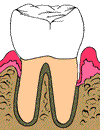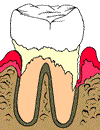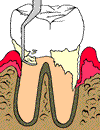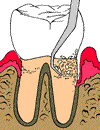|
Gum treatment is the treatment of active gum
and jaw bone disease. The treatment can slow or
stop the progression of the disease. Since there are
different stages of gum disease (from gingivitis to
advanced periodontitis), there are different levels
of treatment. In some cases, the patient may be referred
to a specialist.
Gum treatment consists of one or more of the following
procedures, depending on the individual case:
Scaling and Root Planing
|
|
Scaling and Root Planing is a common non-surgical
treatment for periodontal disease. By using special
instruments, we remove bacteria and infection from
the unhealthy deep pockets around the teeth below
the gum line. This is often referred to as a "deep
cleaning". |
| First the tooth is scaled to remove the
plaque and tarter that has accumulated on the tooth. |
|
|
|
Then the root is planed or smoothed. This
eliminates any rough areas on the root that can
easily trap plaque and bacteria. |

A smooth clean root provides a healthy environment to
allow the gums to heal naturally and reattach to the
tooth. This will create a reduced pocket, therefore
eliminating areas for bacteria to hide and cause further
disease.
Scaling and Root Planing combined with a strict home
care routine and more frequent periodontal cleanings
and exams will increase your chances of keeping your
natural smile.
Gum Surgery
Sometimes, in order to treat advanced gum disease,
surgical procedures are necessary, such as:
Oral Medications
| PerioMed™ and Peridex® are prescription
mouth rinses that reduce the redness, swelling and
bleeding of gums caused by gingivitis. Dr. Dunn or Dr. Bowling
may prescribe these medications for use between
visits. |
|
|
Strict Home Care Regimen
A home care routine specific to the patient's individual
needs may be prepared to prevent the patient from relapsing.
|














